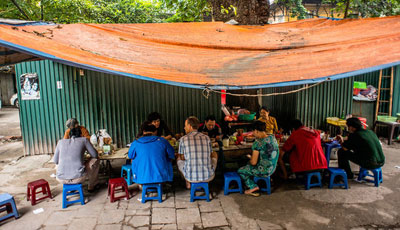By Mike Ives, The New York Times
HANOI — At 8:35 a.m. on a recent Friday morning, Justin Yap stood in the lobby of his hotel wondering what he would eat for breakfast.
Mark Lowerson, in a checked shirt, joins Justin Yap, in the blue windbreaker, at Mrs. Tuyet’s bun rieu cha stall in Hanoi. Bun rieu cha is a dish made of barbecued pork belly served over a soup of crab, pork, tomato, herbs and noodles. Justin Mott for the International Herald Tribune

He had traveled to Vietnam on business, but he had nothing scheduled until 3 p.m.; Mr. Yap, a Canadian who is based in Istanbul and works in international development, was taking most of the day off to eat Vietnamese street food.
He was greeted by Mark Lowerson, an Australian food blogger and co-owner of Hanoi Street Food Tours, a local business offering visitors a taste of the Vietnamese capital’s most eclectic sidewalk eats. (Mr. Yap had discovered the business’s Web site while browsing the Internet for dining recommendations.)
The two men shook hands and climbed into a taxi. As the driver weaved through motorbike traffic toward the weathered French colonial buildings of Hanoi’s low-rise old quarter, Mr. Yap said he had been to Hanoi seven times, but didn’t speak Vietnamese or feel comfortable ordering street food alone.
Mr. Lowerson, wearing shorts and sandals, nodded solemnly like a doctor preparing to diagnose a patient. “We can break down some barriers for you,” he said. “Next time maybe you’ll have the skills to do it on your own.”
Mr. Lowerson, who moved to Hanoi in 2002 and runs the tour business with his Vietnamese partner and business colleague, Van Cong Tu, said he enjoys introducing tourists to culinary and cultural nuances they wouldn’t otherwise discover.
“It’s very easy in Vietnam for people just to get railroaded in a particular direction when they’re traveling,” Mr. Lowerson said. “People gravitate to us because they feel like they’re getting under the surface a little bit more.”
He is among a small group of foreign entrepreneurs whose business models are rooted in a familiarity with Vietnamese cuisine.
The French chef Didier Corlou has four Hanoi restaurants, three of which serve stylized variations of local favorites. The Australian chef Tracey Lister owns the Hanoi Cooking Center, which offers street-food tours and classes in Vietnamese cooking. Both chefs also write cookbooks about Vietnamese food for Western audiences.
Three entrepreneurs — from Britain, Switzerland and Vietnam, respectively — own Highway4, a group of five Hanoi restaurants serving Vietnamese food and the award-winning Vietnamese rice liquors they produce in a local distillery.
In Saigon, Barbara Adam, an Australian, and her Vietnamese husband, Vo Vu, began offering food tours last year through their business Saigon Street Eats. The American chef Chad Kubanoff and his Vietnamese wife, Thuy Kubanoff, have given food tours since 2010 through their motorcycle-tour business, Back of The Bike Tours, which now has a staff of 20.
In contrast, Hanoi Street Food Tours is still a two-man operation. Mr. Lowerson said he likes it that way and doesn’t plan to hire anyone.
Mr. Lowerson, 48, and Mr. Tu, 36, went into business together in 2009 on an ad-hoc basis, after dozens of tourists e-mailed Mr. Lowerson through his food blog, Stickyrice, requesting guided tours or street-food recommendations, he said.
At the time, Mr. Lowerson was running an educational project financed by the Australian government, and Mr. Tu was the maître d’ at an upscale Vietnamese restaurant in Hanoi. “Initially, because I was working, I’d say, ‘Sorry, can’t help you,”’ Mr. Lowerson recalled. “It took me a while to work out that there was a business opportunity.”
Their half- and full-day tours are $75 and $135 per person, respectively, and most of their clients are from Australia, the United States or northern Europe, Mr. Lowerson said. A local travel agency books 40 percent of their tours, but the rest are arranged independently — even though the couple does no formal marketing.
It helps that Mr. Lowerson has more than 2,000 Twitter followers, a few of them professional food writers, and that his 8-year-old food blog runs to nearly a quarter of a million words.
Guests from several countries have raved about the experience, saying it was a good way to get off the beaten path in a city with so many tourists.
Read the full article by Mike Ives of the New York Times.

